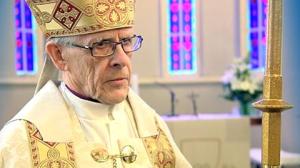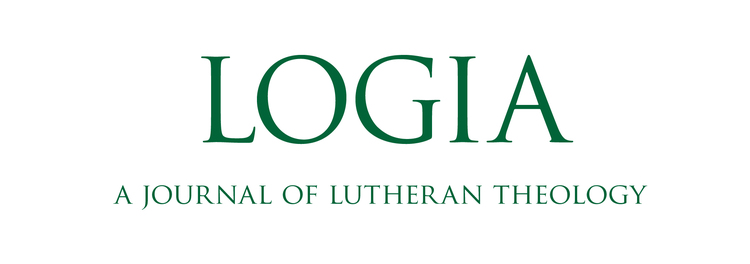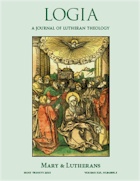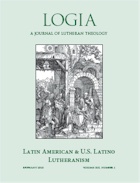
Bishop Matti Väisänen, recently consecrated as assistant bishop in the Mission Province in Sweden and Finland, has been defrocked by the Tampere Cathedral Chapter.
The following explanation was offered by Tapani Simijoki (by permission) from his blog SimonPotamos:
Bishop Matti Väisänen of Luther Foundation Finland (LFF), the Finnish partner to Mission Province in Sweden and Finland, was defrocked on Wednesday 08/11 by the Cathedral Chapter of Tampere Diocese led by Bishop Matti Repo. The basis of defrocking was the episcopal ordination of Väisänen in last March. Prior to this, Väisänen had served as a pastor in the Evangelical-Lutheran Church of Finland for 46 years, and is a well-known figure in the confessional movement inside the Finnish national church.
Väisänen was called to serve as a bishop in the Mission Province, the care of Finnish pastors and congregations as his primary task. Luther Foundation and Mission Province are reacting to the rapidly increasing liberalism and secularism inside the Scandinavian established churches, the key issues being the ordination of women and - lately - blessing of the same-sex partnerships. For already ten years, it has been practically impossible for candidates refusing to accept female clergy to receive ordination into the pastoral office, while the members of the church with similar conviction find it increasingly difficult to find places to worship in anymore. Luther Foundation has countered this problem by calling and ordaining its own pastors via Mission Province, assigning them with the task of serving new congregations in Finland. Neither these pastors nor the congregations they serve are recognized by the established church.
Väisänen continues to serve as bishop in the Mission Province of Sweden and Finland.
Read a response in support of the Bishop (an English translation in pdf) by Luther Foundation Finland.
Read also the personal defense by Bishop Väisänen himself (offered here by permission):
TO TAMPERE CATHEDRAL CHAPTER
SUBJECT
Response in a case concerning a disciplinary procedure
RESPONDENT
Matti Väisänen ThD
DISCIPLINARY CHARGE
The disciplinary charge by the disciplinary commissioner of Tampere Cathedral Chapter, Kari Ikonen, concerning my deposing from the pastoral office 9 June 2010
RESPONSE TO THE CHARGE
I am opposed to the disciplinary charge. I do not consider myself to have acted contrary to the responsibilities of my pastoral office.
In my ordination oath I have primarily bound myself to remain faithfully and purely in God’s holy word and in our church’s confession founded on it. According to the confession, the church’s highest rule is that all doctrine must be examined and evaluated according to God’s holy word. This biblical principle — sola Scriptura – and commitment to the Lutheran confessions is even today the legally in force in our church and is recorded in the first article of the Church Law, the so called Confessional Article. For that reason, the church’s confession binds not only the pastor but also the church’s order to being primarily obedient to God’s holy word, which is the Bible.
Because shepherds who bind themselves to the apostolic view on the office of the ministry are no longer being ordained in our church, I have received the office of bishop. The justification for this ecclesial emergency right is based on the Holy Bible and the Lutheran confessions. It is not an offence against the ordination oath but in the most profound sense precisely acting in accordance with the duties of that oath.
On the precise basis of the ecclesial emergency right, I refer to the attached article by pastor Anssi Simojoki, ThD. [Editor's note—There is no link to the article referenced by the author here]
Arguments
Concerning the episcopal consecration
I have been ordained as bishop by an association called Missionsprovinsen i Sverige och Finland (hereafter Missionsprovinsen). The association is not outside the Church of Sweden but works within the Church of Sweden. However it — any more than any other association — cannot be an actual member of the Church of Sweden. Missionsprovinsen defines itself as a non-geographical diocese in the tradition of the churches of Sweden and Finland.
Also Luther Foundation Finland, in which I am a member and vice chairman of the Executive Council, works within the church. In Luther Foundation, we are concerned about our church’s current theological-spiritual orientation, which is detaching itself from God’s word. We are especially concerned that shepherds who bind themselves to the apostolic view on the office of the ministry are no longer being ordained.
It is my understanding that bishops have begun to impose this ordination block after bishop Olavi Rimpiläinen retired in 2000.
Concerned about the state of our church we have been forced—being guided and obliged by the Confessional Article of our Church Law and the Lutheran Confessions (Treatise, 60ff.), and with their justification—to take action in order to preserve apostolic worship and teaching in our church and our land.
Because Luther Foundation Finland is an associate member of Missionsprovinsen, this relationship has made it possible to begin the founding of an independent Mission Diocese / Mission Province in our church with its own worshipping communities / congregations, pastors and bishops.
Concerning the use of the external marks of a bishop
I have been elected bishop by the provinskonvent of Missionsprovinsen. The consecration was carried out by the Mission Bishop of Missionsprovinsen, Arne Olsson. He was assisted by the Archbishop of the Evangelical Lutheran Church in Kenya, Walter Obare, and Missionsprovinsen bishops Lars Artman and Göran Beijer.
Arne Olsson was consecrated bishop by Archbishop Walter Obare in 2005. Walter Obare was consecrated bishop by the Archbishop of the Evangelical Lutheran Church of Tanzania, Samson Mushemba, in 2002. One of the assistants at the consecration of Walter Obare was bishop Olavi Rimpiläinen.
Because I have been called and properly consecrated into the office of bishop, I have not used the external marks of a bishop in any way without justification, for in terms of church law,† I am a Lutheran bishop.
Concerning the conducting of an episcopal mass
I have conducted an episcopal mass, including the celebration of the Lord’s Supper, as part of the carrying out of the duties of my office on 16 May 2010 in a place not authorised for that purpose.
Our church’s cathedral chapters, which are negatively disposed to those who have an apostolic view of the office of the ministry, do not permit us to celebrate the mass and the Lord’s Holy Supper in church and would not allow us to celebrate it outside the church either. Knowing this, why would we trouble ourselves any more than the cathedral chapters with our applications . In this matter, too, we have had to resort to the rights given to us by the Lutheran confessions and to seek for our congregations alternative premises, trusting that God’s word and prayer consecrate them as sacred spaces.
Concerning the alleged misleading of members of the church
When I accepted the call to become a bishop of Missionsprovinsen, and in serving the congregations that have been born in Finland as a result of the work of Luther Foundation, I am misleading no one, for we have made, and will continue to make, clear to everyone that I am a bishop of Missionsprovinsen, not a bishop according to the our church’s parochial diocesan order.
Nor have I taken a leading role in another denomination or another religious organisation, since Missionsprovinsen is registered as an ideological association. In terms of its organisation, it does not work within the administrative structures of the churches of Sweden or Finland. Rather, it continues the church’s spiritual heritage as a free diocesan structure, serving here in Finland those members of the Evangelical Lutheran Church of Finland who have been left homeless because of their traditional view on the office of the ministry.
Concerning the alleged breach of the ordination vows
Therefore, I absolutely deny having broken the ordination vow I swore in 1964. If Tampere Cathedral Chapter deposes me from the office of the ministry, it will take place precisely because I have remained faithful to my ordination vow.
It is characteristic of our church’s current theological-spiritual state of humiliation that the church has increasingly replaced its own ecclesiastical justice‡ with civil service law and secular laws, seeking again to become a state church. The governing organs of our church have brought our church to a situation where the church’s constitution (Bible + the Lutheran confessions) and the church’s order have come to a conflict. At the same time, the bishops and cathedral chapters demand obedience to church order against the church’s constitution. That which is human takes precedence over that which is divine. Man’s word and man is elevated in our church above God’s word and God. Thus the church, having broken its judicial foundation, changes increasingly into a travesty of a church with its rites and blessings of civil religion.
I am saddened that this distortion leads to oppression against those who consider the Bible the unchanging word of God. Today it looks like holding to Gods word is a crime in our church. By contrast, those who deny Christ’s divinity and atoning work, and even the existence of a personal God, and those who live immorally, are allowed to work in our church as pastors and bishops, destroying our church without any disciplinary consequences, while those who want to be faithful to God’s word are dismissed from their posts.
Here I stand; I cannot do otherwise. So help me God! (Martin Luther, 1521)
DATE AND SIGNATURE
In Ryttylä, on the Ninth Sunday after Pentecost, AD 2010
Matti Väisänen
Bishop
Missionsprovinsen i Sverige och Finland
Jyrki Anttinen
Solicitor
The Bishop’s Attorney
† That is, ecclesiastical jurisprudence (Kirchenrecht), not the Church Law of the Republic of Finland. Tr.
‡ See previous note. Tr.
Editor's note—Thanks to contributing editor John Stephenson for the heads up concerning this news.

 Holy Trinity 2010, Volume XIX, Number 3
Holy Trinity 2010, Volume XIX, Number 3 Eastertide 2010, Volume XIX, Number 2
Eastertide 2010, Volume XIX, Number 2


 Epiphany 2010, Volume XIX, Number 1
Epiphany 2010, Volume XIX, Number 1